I have the following current output: 
And I am aiming for a colouring like this, but only filled until the maximum level (e.g the fill stops at the level present):
The data to create this, is:
df <- tribble(~Question_Code, ~RespondentLevel,
"Engagement - Inclusion", 5,
"External engagement - policies", 2,
"External engagement - technology", 5,
"Community data ", 5,
"Internal engagement", 5,
"Internal use of technology", 4,
"Familiarity/Alignment", 5,
"Environmental impacts", 5,
"Innovation", 2,
"Use of open-source technology", 2,
"Regulation of hardware & software", 5,
"In-house technical capacity", 5,
"Infrastructure procurement", 5,
"Algorithmic Error & Bias", 2,
"Control: Privacy", 5,
"Accountability in Governance Structures", 3,
"Open procurement", 5,
"Use in decision-making", 1,
"Accountability", 1,
"External Control", 4,
"Internal Control", 2,
"Open Data", 2)
levels <- c("Open Data","Internal Control","External Control","Accountability",
"Use in decision-making","Open procurement","Accountability in Governance Structures","Control: Privacy",
"Algorithmic Error & Bias","Infrastructure procurement","In-house technical capacity",
"Regulation of hardware & software","Use of open-source technology","Innovation",
"Environmental impacts","Familiarity/Alignment",
"Internal use of technology","Internal engagement","Community data",
"External engagement - technology","External engagement - policies","Engagement - Inclusion")
df <- df %>% mutate(Domain = c(as.character((rep("Domain 1", 5))),
as.character(rep("Domain 2", 4)),
as.character(rep("Domain 3", 6)),
as.character(rep("Domain 4", 7))))
And for the ggplot:
df %>%
ggplot(aes(x = RespondentLevel, y = fct_rev(Question_Code))) +
geom_tile() +
theme_minimal(16)
The colours to fill, I'm using:
with each colour corresponding to a domain, and each shade to a level:
Greens <- c("#edf8e9", "#bae4b3", "#74c476", "#31a354", "#006d2c")
Reds <- c("#fee5d9", "#fcae91", "#fb6a4a", "#de2d26", "#a50f15")
Yellows <- c("#ffffeb","#ffff9d","#ffff89", "#ffff4e", "#ffff14")
Blues <- c("#eff3ff","#bdd7e7","#6baed6","#3182bd", "#08519c")
EDIT: geom_bar also does the trick, but not broken down by gradient. Trying to use this function:
ColourPalleteMulti <- function(df, group, subgroup){
# Find how many colour categories to create and the number of colours in each
categories <- aggregate(as.formula(paste(subgroup, group, sep="~" )), df, function(x) length(unique(x)))
category.start <- (scales::hue_pal(l = 100)(nrow(categories))) # Set the top of the colour pallete
category.end <- (scales::hue_pal(l = 40)(nrow(categories))) # set the bottom
# Build Colour pallette
colours <- unlist(lapply(1:nrow(categories),
function(i){
colorRampPalette(colors = c(category.start[i], category.end[i]))(categories[i,2])}))
return(colours)
}
colours <- ColourPalleteMulti(df, "Domain", "RespondentLevel")
df %>%
ggplot(aes(x = fct_rev(Question_Code), y = RespondentLevel))+
geom_bar(stat = "identity", aes(fill = Domain), alpha = .9) +
coord_flip() +
theme_minimal(16)+
xlab(" ") +
ggtitle("Baseline Report Card Sample Community")+
scale_fill_manual("RespondentLevel", values = colours)+
theme(legend.title = element_text(size = 14),
legend.position = "none",
legend.text = element_text(size = 14),
plot.title = element_text(size=18, hjust = 0.5),
plot.caption = element_text(size = 12, hjust = 1),
axis.text.y = element_text(hjust = 0),
panel.grid = element_line(colour = "#F0F0F0"),
plot.margin = unit(c(1,1,0.5,1), "cm"))
Sorry for the long reprex, can adjust if possible



